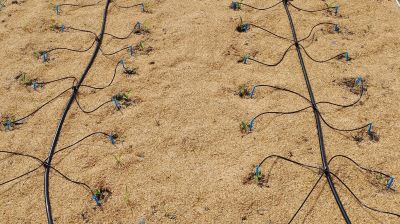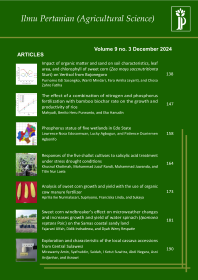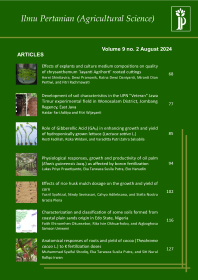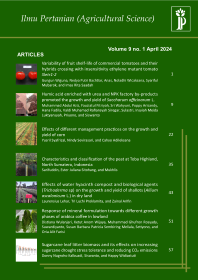
Effects of rice husk mulch dosage on the growth and yield of corn
Yusril Syafrizal(1), Nindy Sevirasari(2), Cahyo Adileksana(3), Stella Nostra Gracia Plena(4*)
(1) Edufarmers International Foundation
(2) Edufarmers International Foundation
(3) Edufarmers International Foundation
(4) Edufarmers International Foundation
(*) Corresponding Author
Abstract
Drought significantly affects corn phenology and yield. Rice husk mulching is a technical cultural strategy to mitigate water stress caused by drought. This research aimed to determine the optimal dosage of rice husk mulch for the growth and yield of corn. Determining the optimal dosage of rice husk mulch is essential for agricultural efficiency, environmental sustainability, and plant health. A single-factor Randomized Complete Block Design was arranged for this research. The treatment consisted of varying dosages of rice husk mulch, namely 2; 4; 6; 8 kg.m⁻² rice husk mulch and without rice husk mulch. The data were analyzed using Analysis of Variance and followed by the Post Hoc Tukey’s HSD at α= 5%. The highest of plant height (185.99 cm), number of leaves (12.58), stem diameter (23.32 mm), stem dry weight (146.40 g), leaf dry weight (37.20 g), root dry weight (53.90 g), total dry weight (237.50 g), and suppressed weeds up to 234.47% were achieved in 6 kg.m⁻² rice husk mulch. At this dosage, it impacts the optimal cob weight with cornhusk and the dry weight of the kernels. The optimal dosage of rice husk mulch was 5.9 kg.m⁻². This study shows that optimizing plant height and cob weight with cornhusk per plant are key indicators for achieving high corn yield. The study demonstrates that rice husk mulch can suppress weeds, and enhance corn growth and yield during drought, compared to conditions without rice husk mulch.
Keywords
Full Text:
PDFReferences
Agus, F., Andrade, J. F., Rattalino Edreira, J. I., Deng, N., Purwantomo, D. K. G., Agustiani, N., Aristya, V. E., Batubara, S. F., Herniwati, Hosang, E. Y., Krisnadi, L. Y., Makka, A., Samijan, Cenacchi, N., Wiebe, K., and Grassini, P. (2019). Yield gaps in intensive rice-maize cropping sequences in the humid tropics of Indonesia. Field Crops Research, 237, pp. 12–22.
Alhashimi, A., AL-Huqail, A., Hashem, M., Bakr, B., Fekry, W., Abdel-Aziz, H., Hamdy, A., Abdelraouf, R., and Fathy, M. (2023). Using Deficit Irrigation Strategies and Organic Mulches for Improving Yield and Water Productivity of Mango under Dry Environment Conditions. Agriculture, 13(7), pp. 1–21.
Aman, J., Bantte, K., Alamerew, S., and Sbhatu, D. B. (2020). Correlation and Path Coefficient Analysis of Yield and Yield Components of Quality Protein Maize (Zea mays L.) Hybrids at Jimma, Western Ethiopia. International Journal of Agronomy, 2020, pp. 1–7.
Aristya, V. E., and Samijan, S. (2022). The Yield Gap Maize under Intensive Cropping System in Central Java. Planta Tropika: Jurnal Agrosains (Journal of Agro Science), 10(1), pp. 1–12.
Asif, M., Nadeem, M. A., Aziz, A., Safdar, M. E., Adnan, M., Ali, A., Ullah, N., Akhtar, N., and Abbas, B. (2020). Mulching improves weeds management, soil carbon and productivity of spring planted maize (Zea mays L.). Int J Bot Stu, 5(2), pp. 57–61.
Aung, Z. M., and Zar, T. (2023). Effects of different mulching materials on yield and yield components of maize (Zea mays L.). Journal of Agriculture and Applied Biology, 4(1), pp. 1–10.
Berry, K. J. (1993). Orthogonal Polynomials for the Analysis of Trend. Educational and Psychological Measurement, 53(1), pp. 139–141.
Chiroma, A. M., Folorunso, O. A., and Alhassan, A. B. (2006). The effects of land configuration and wood-shavings mulch on the properties of a sandy loam soil in Northeast Nigeria. 1. Changes in chemical properties. Tropicultura, 24(3), pp. 129–134.
Demo, A. H., and Bogale, G. A. (2024). Enhancing crop yield and conserving soil moisture through mulching practices in dryland agriculture. Frontiers in Agronomy, 6, pp. 1–14.
Dewi, P. P. (2009). Climate change impacts on tropical agriculture and the potential of organic agriculture to overcome these impacts. Asian Journal of Food and Agro-Industry, 2, pp. 10–17.
Dietz, K. J., Zörb, C., and Geilfus, C. M. (2021). Drought and crop yield. Plant Biology, 23(6), pp. 881–893.
Erenstein, O., Jaleta, M., Sonder, K., Mottaleb, K., and Prasanna, B. M. (2022). Global maize production, consumption and trade: trends and R&D implications. Food Security, 14(5), pp. 1295–1319.
Eze, P. C., Onyekwere, I. N., Balogun, I. A., Tsado, P. A., and Azuatalam, C. E. (2019). Effect of method and rate of application of rice husk-residue on maize plant height and yield in Minna, Nigeria. Food Insecurity in Nigeria: Agricultural Diversifications as Panacea. Proceedings of the 1st International Conference of Agriculture and Agricultural Technology (ICAAT 2019) Held at Federal University of Technology, Minna, from 23rd–26th April, pp. 245–250.
FAO. (2022). Agricultural production statistics 2000–2021. In FAOSTAT Analytical Brief Series 60, Rome: FAO.
Gallegos-Cedillo, V. M., Diánez, F., Nájera, C., and Santos, M. (2021). Plant agronomic features can predict quality and field performance: a bibliometric analysis. Agronomy, 11(11), pp. 1–32.
Gupta, P. S., Abbas, M., and Singh, P. P. (2023). Optimizing Maize Harvests: Unraveling the Impact of Organic Mulching on Yield Parameters. Indus Journal of Animal and Plant Sciences, 1(2), pp. 48–53.
Hama, B. M., and Mohammed, A. A. (2019). Physiological performance of maize (Zea mays L.) under stress conditions of water deficit and high temperature. Applied Ecology and Environmental Research, 17(1), pp. 1261–1278.
Hatfield, J. L., and Dold, C. (2018). Climate Change Impacts on Corn Phenology and Productivity. In: Amanullah and Fahad, S., ed., Corn - Production and Human Health in Changing Climate. InTech, pp. 95–114.
Hilty, J., Muller, B., Pantin, F., and Leuzinger, S. (2021). Plant growth: the What, the How, and the Why. New Phytologist, 232(1), pp. 25–41.
Irmak, S., Mohammed, A. T., and Kukal, M. S. (2022). Maize response to coupled irrigation and nitrogen fertilization under center pivot, subsurface drip and surface (furrow) irrigation: Growth, development and productivity. Agricultural Water Management, 263, pp. 1–53.
Islam, M., Alam, M., Salahin, N., Alam, M., Hussen, M., and Mondol, A. (2022). Effects of tillage, mulch and irrigation on maize (Zea mays L.) yield in drought prone area. Bangladesh Journal of Agriculture, 47(1), pp. 27–38.
Khan, I., Iqbal, B., Khan, A. A., Inamullah, Rehman, A., Fayyaz, A., Shakoor, A., Farooq, T. H., and Wang, L. X. (2022). The Interactive Impact of Straw Mulch and Biochar Application Positively Enhanced the Growth Indexes of Maize (Zea mays L.) Crop. Agronomy, 12(10), pp. 1–12.
Kim, K., and Lee, B. (2023). Effect of Climate Change and Drought Tolerance in Maize Growth. Plants, 12(3548), pp. 1–18.
Kumar, R. S., Bridgit, T. K., and Chanchala, A. (2018). Physical and Chemical Properties of Sandy Soil as Influenced by the Application of Hydrogel and Mulching in Maize (Zea mays L.). International Journal of Current Microbiology and Applied Sciences, 7(07), pp. 3612–3618.
Kusbiantoro, D., Siregar, L. A. M., Hanum, C., and Mawarni, L. (2023). Effect of mulch weight on temperature, soil moisture and vegetative growth of Sigambiri Merah in lowlands. IOP Conference Series: Earth and Environmental Science, 1241(1), pp. 1–7.
Lara, M. V., and Andreo, C. S. (2011). C4 plants adaptation to high levels of CO₂ and to drought environments. In: Shanker, A., and Venkateswarlu, B., ed., Abiotic Stress in Plants - Mechanisms and Adaptations. Intech.
Lopes, M. S., Araus, J. L., Van Heerden, P. D. R., and Foyer, C. H. (2011). Enhancing drought tolerance in C 4 crops. Journal of Experimental Botany, 62(9), pp. 3135–3153.
Marpaung, N. K., Sutrawati, M., Novanda, R. R., Ganefianti, D. W., and Pamekas, T. (2022). Weeds Associated with Papaya Plants (Carica Papaya L.) in Bengkulu. AGRITROPICA : Journal of Agricultural Sciences, 5(2), pp. 76–82.
Mota, M. M., van Der Watt, E., and Khetsha, Z. P. (2024). Foliar Application of Brassinosteroids Improves the Yield and Morpho-Physiological Characteristics of Arachis Hypogaea L., Glycine Max (L.), and Phaseolus Vulgaris L. Applied Ecology and Environmental Research, 22(1), pp. 355–371.
Naresh, R. K. (2022). Advances in Agriculture Sciences. In Advances in Agriculture Sciences Volume 40. New Delhi: AkiNik Publications.
Nasution, I. S., Satriyo, P., Ichwana, Yolanda, S., and Alma, A. (2021). Non-destructive measurement of leaf area and leaf number of hydroponic pak-choy plants (Brassica rapa). IOP Conference Series: Earth and Environmental Science, 644(1), pp. 1–9.
Nielsen, R. L. (Bob). (2019). Determining Corn Leaf Stages. [online] Department of Agronomy, Purdue University. Available at: https://www.agry.purdue.edu/ext/corn/news/timeless/VStageMethods.html [Accessed 28 May 2024]
Nurjanah, U., Memed, Setyowati, N., Muktamar, Z., Suprijono, E., and Turmudi, E. (2023). Effect of Planting Patterns and Mulch Types on Weed Growth and Yield of Sweet Corn and Red Bean. International Journal of Plant & Soil Science, 35(5), pp. 37–45.
Nurjanah, U., Setyowati, N., Prasetyo, P., Fahrurrozi, F., and Muktamar, Z. (2021). Weed growth and sweet corn yield as affected by planting patterns and mulch types in organic farming practice. IOP Conference Series: Earth and Environmental Science, 694(1), pp. 1–7.
Ouyang, Z., Tian, J., Yan, X., and Shen, H. (2021). Effects of different concentrations of dissolved oxygen on the growth, photosynthesis, yield and quality of greenhouse tomatoes and changes in soil microorganisms. Agricultural Water Management, 245(539), pp. 1–9.
Padafani, B. D. B. (2022). Effect of Urea and KCl Fertilization on the Growth and Results of Gogo Rice of Situ Pateggang Variety. Jurnal Penelitian Pendidikan IPA, 8(6), pp. 3159–3164.
Park, J. H., Yun, J. J., Kim, S. H., Park, J. H., Acharya, B. S., Cho, J. S., and Kang, S. W. (2023). Biochar improves soil properties and corn productivity under drought conditions in South Korea. Biochar, 5(1), pp. 1–11.
Paul, K. I., Larmour, J. S., Roxburgh, S. H., England, J. R., Davies, M. J., and Luck, H. D. (2017). Measurements of stem diameter: implications for individual- and stand-level errors. Environmental Monitoring and Assessment, 189(8), pp. 1–14.
Pusparini, P. G., Yunus, A., and Harjoko, D. (2018). Dosis Pupuk NPK Terhadap Pertumbuhan dan Hasil Jagung Hibrida. Agrosains: Jurnal Penelitian Agronomi, 20(2), pp. 28–33.
Qaderi, M. M., Martel, A. B., and Dixon, S. L. (2019). Environmental factors influence plant vascular system and water regulation. Plants, 8(3), pp. 1–23.
Qi, Y., Zhang, Q., Hu, S., Wang, R., Wang, H., Zhang, K., Zhao, H., Ren, S., Yang, Y., Zhao, F., Chen, F., and Yang, Y. (2022). Effects of High Temperature and Drought Stresses on Growth and Yield of Summer Maize during Grain Filling in North China. Agriculture (Switzerland), 12(11), pp. 1–14.
Rachana, P., Binju, M., Suprava, A., K.C., B., Rishav, P., Rashmi, R., Bishnu, B., Pritika, N., Kushal, B., and Ram, P. M. (2021). Correlation and Path Coefficient Analysis of Yield in Wheat: a Review. Russian Journal of Agricultural and Socio-Economic Sciences, 113(5), pp. 121–127.
Ramli. (2017). The Effect of Rice Husk Mulch’s Dosage on the Production Growth of Some Cabbage Varieties (Brassica oleracea L.). IOSR-JAVS, 10(8), pp. 38–41.
Ransom, J., and Endres, G. (2020). Corn growth and management Quick Guide. NDSU Extension, 1173, pp. 1–8.
Ray, R. L., Ampim, P. A. Y., and Gao, M. (2020). Crop Protection Under Drought Stress. In: Jabran, K., Florentine, S., Chauhan, B., ed., Crop Protection Under Changing Climate. Springer, pp. 145–170.
Riyanto, D., Budiarti, S. W., Jihad, M., Yustisia, Khairullah, I., and Widowati, R. (2023). Implementation of Supplementary Water Irrigation and Rice Husk for Climate Change Adaptation and Improving Soil Quality in Dry Land, Gunungkidul. E3S Web of Conferences IConARD, 44, pp. 1–10.
Salahudeen, A. B., and Sadeeq, J. A. (2018). Use of rice husk and sawdust as composite mulching material for onion. Conference: Ahmadu Bello University, Zaria, National Conference, pp. 1–4.
Sam, T. T., Nhi, P. T. T., Mai, N. T. H., Linh, D. Q., and Loi, P. T. (2023). The climate change effects on agricultural drought in the Be River Basin. IOP Conference Series: Earth and Environmental Science, 1170(1), pp. 1–11.
Saranya, P., Sri Gayathiri, C. M., and Sellamuthu, K. M. (2018). Potential Use of Rice Husk Ash for Enhancing Growth of Maize (Zea mays). International Journal of Current Microbiology and Applied Sciences, 7(03), pp. 899–906.
Schober, P., Boer, C., and Schwarte, L. A. (2018). Correlation coefficients: Appropriate use and interpretation. Anesthesia and Analgesia, 126(5), pp. 1763–1768.
Sharma, S., Basnet, B., Bhattarai, K., Sedhai, A., and Khanal, K. (2023). The influence of different mulching materials on Tomato’s vegetative, reproductive, and yield in Dhankuta, Nepal. Journal of Agriculture and Food Research, 11, pp. 1–7.
Shen, D., Zhang, G., Xie, R., Ming, B., Hou, P., Xue, J., Li, S., and Wang, K. (2020). Improvement in photosynthetic rate and grain yield in super-high-yield maize (Zea mays L.) by optimizing irrigation interval under mulch drip irrigation. Agronomy, 10(11), pp. 1–14.
Shimizu, G. D., and Gonçalves, L. S. A. (2023). AgroReg: main regression models in agricultural sciences implemented as an R Package. Scientia Agricola, 80, pp. 1–11.
Suwandi. (2022). Laporan Kinerja Direktorat Jenderal Tanaman Pangan. [pdf] Jakarta: Kementerian Pertanian. Available at: https://tanamanpangan .pertanian.go.id/assets/front/uploads/ document/LAKIN DJTP 2022_UPDATE ATAP (2).pdf [Accessed 28 May 2024]
Tabrani, H., and Saiful, S. A. (2023). Management of Hybrid Corn Technology Application in Gorontalo. Journal of Public Administration and Government, 5(1), pp. 50–58.
Tian, X., Bai, Y., Li, G., Yang, X., Huang, J., and Chen, Z. (2023). An Adaptive Feature Fusion Network with Superpixel Optimization for Crop Classification Using Sentinel-2 Imagery. Remote Sensing, 15(8), pp. 1–23.
Ukalska, J., and Jastrzȩbowski, S. (2019). Sigmoid growth curves, a new approach to study the dynamics of the epicotyl emergence of oak. Folia Forestalia Polonica, 61(1), pp. 30–41.
Wamanrao, A. N., Kumar, V., and Meshram, D. (2020). Correlation and Path Coefficient Analysis of Grain Yield and its Growth Components in Soybean (Glycine max. L.). International Journal of Current Microbiology and Applied Sciences, 9(3), pp. 2445–2451.
Wang, Z., Li, Y., Su, X., Tao, S., Feng, X., Wang, Q., Xu, X., Liu, Y., Michaletz, S. T., Shrestha, N., Larjavaara, M., and Enquist, B. J. (2019). Patterns and ecological determinants of woody plant height in eastern Eurasia and its relation to primary productivity. Journal of Plant Ecology, 12(5), pp. 791–803.
Wróblewska, K., Szumny, A., Żarowska, B., Kromer, K., Dębicz, R., and Fabian, S. (2019). Impact of mulching on growth essential oil composition and its biological activity in Monarda didyma L. Industrial Crops and Products, 129, pp. 299–308.
Yang, P., Wu, L., Cheng, M., Fan, J., Li, S., Wang, H., and Qian, L. (2023). Review on Drip Irrigation: Impact on Crop Yield, Quality, and Water Productivity in China. Water (Switzerland), 15(9), pp. 2–18.
Zhang, N., Qu, Y., Song, Z., Chen, Y., and Jiang, J. (2022). Responses and sensitivities of maize phenology to climate change from 1971 to 2020 in Henan Province, China. PLoS ONE, 17(1 1), pp. 1–13.
Article Metrics
Refbacks
- There are currently no refbacks.
Ilmu Pertanian (Agricultural Science) ISSN 0126-4214 (print), ISSN 2527-7162 (online) is published by Faculty of Agriculture Universitas Gadjah Mada collaboration with Perhimpunan Sarjana Pertanian Indonesia (PISPI) and licensed under a Creative Commons Attribution-ShareAlike 4.0 International License.














